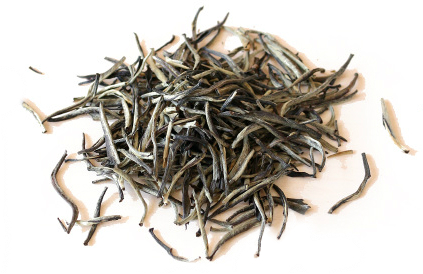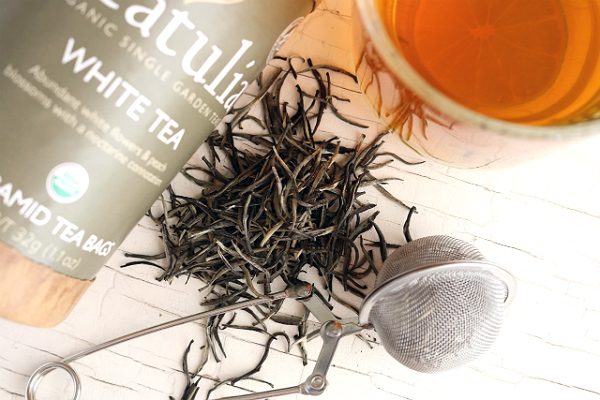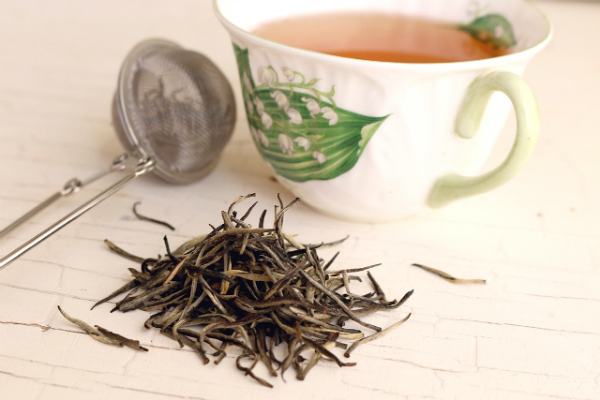Cùng xem What is White Tea? trên youtube.
White tea is known to be one of the most delicate tea varieties because it is so minimally processed. White tea is harvested before the tea plant’s leaves open fully, when the young buds are still covered by fine white hairs, hence the name “white” tea.
These buds and unfurled leaves from the newest growth on the tea plant are handpicked and then quickly and meticulously dried, so the leaves are not allowed to oxidize as long as leaves plucked for green or black tea production. This minimal processing and low oxidation results in some of the most delicate and freshest tea available.
Bạn đang xem: white tea
SHOP WHITE TEA >>
What’s oxidation got to do with it?
It’s important to know that all tea—white, green, oolong, black and even pu-erh—comes from the same Camellia sinensis plant, an evergreen bush indigenous to both China and India. Hundreds of cultivars and hybrids have evolved from the Camellia sinensis plant over time, each thriving in diverse geographical areas of the world. But it’s ultimately the variety of tea plant and how the plant’s leaves are processed that defines the final type of tea that ends up in your teacup.
One of the biggest differentiators in how various teas are processed is oxidation—that is, how long tea leaves are allowed to be exposed to oxygen once they’ve been harvested. The longer tea leaves are exposed to oxygen, the darker the leaves become and the deeper the flavor profile that’s developed. During processing, tea masters use many different methods to create and control oxidation, including rolling, shaping or crushing the leaves to speed up oxidation, and steaming, firing or roasting the leaves to stop it.
White Tea: Green Bud → Withering (72 hrs) → Drying (110°C/65°C)
Tham khảo: Điện cảm là gì? Phân loại cuộn cảm, tác dụng của cuộn cảm
Xem Thêm : The vang TV: Câu lạc bộ bóng đá West Ham United – Niềm tự hào của thủ đô London
Our white tea is neither rolled nor fired, so it is essentially non-oxidized and it is the least processed. Instead of being exposed to an artificial heat, the leaves are simply allowed to wither and dry in a carefully controlled environment, which results in the most delicate, fresh-from-the-garden tasting tea.
Black tea leaves are harvested and allowed to fully oxidize before they are heat-processed and dried, creating the deep brown to black color and rich, malty flavor black tea is known for. Green tea leaves are harvested and then quickly heated—by pan firing or steaming—and dried to prevent too much oxidation from occurring that would turn the green leaves brown and alter their fresh-picked flavor.
White tea is so minimally processed that much less oxidation occurs. As soon as the buds are plucked they are allowed to wither and air dry in the sun or in a carefully controlled outdoor or indoor environment. Some buds may be steamed or exposed to low heat to help dry them more quickly to stop oxidation. Some minimal oxidation occurs as the buds are allowed to dry naturally, but since oxidation is not encouraged manually, white tea has a much softer, delicate flavor profile than its green or black tea cousins.
White tea origins
A tea custom developed during the era of early Chinese imperial dynasties (between 600 and 1300) when tea drinking and tea culture was flourishing across the country. The custom was for citizens to pay a yearly tribute to the Emperors of the time in the form of rare and fine teas. Kind of like a tea tax. This imperial tea tribute was typically made from the youngest, newest and most delicate buds from the finest tea plants.
Imperial tea gardens were developed, sometimes in secret, to cultivate these rare, honoring teas. Poets referred to these special teas as being, “white like the clouds, green like a dream, pure like snow, and as aromatic as an orchid.”
These imperial tea tributes are considered the earliest forms of white tea, but they aren’t the white tea we know today. During Emperor Huizong’s rule of the Song Dynasty (960 – 1297), young tea buds would be plucked in the spring, steamed and striped of their outer leaf, meticulously rinsed with spring water, carefully air dried and then ground into a silvery white powder. This white powder would be whisked into hot water to create the finest tea available to the only person in China that could afford it—the Emperor.
Types of white tea
The white tea we know today was first commercially produced from the very first white tea plant varieties discovered in China’s Fujian province in the 1700s—Da Bai and Da Hao. A loose leaf version of white tea was developed from these plants known for producing large and beautiful tea buds.
Because these minimally processed and delicate teas made from young buds were difficult to store and transport without spoiling, white teas were rarely available outside of the tea growing regions in the Fujian province. As loose leaf tea production methods improved, the process for creating white teas expanded beyond the Fujian province and into other regions of the world thirsty for a rare and exquisite tea.
Today, many countries outside China are cultivating their own versions of white tea from other tea plant varieties. Some of the most popular white tea varieties include:
- Bai Hao Yin Zhen (Silver Needle): A true Silver Needle comes from the Fujian province of China and is cultivated from the original varieties of China’s white tea plant. It’s made from large, full buds that are covered with white, downy hairs that give the tea the silver color it’s named for.
- Bai Mudan (White Peony): This newer variety of white tea is cultivated in China and other countries around the world. It can be cultivated from an original Chinese white tea bush or from another variety. It usually includes some buds blended with unfurled or barely opened young tea leaves.
- Monkey Picked White Tea: Rumored to once be harvested by Buddhist-trained monkeys from the highest wild tea tree tops in mountainous regions of China, “monkey-picked” is a term used today to denote a very high-quality Chinese tea made from the buds and young leaves of the tea plant.
- Darjeeling White Tea: This variety is not cultivated from the original Chinese white tea plant variety but from tea plants native to the Darjeeling region of India. The processing method is similar to the Fujian white teas, but the flavor profile tends to be much different.
Tasting white tea
Just like the with the Chinese Emperors and courtesans of ancient times, white teas are still revered today for their delicate, rare and beautiful aromas and flavors. Most white teas are still handpicked and hand processed, making them a true delicacy to sip in appreciation of the artisanship that went into their making.
Xem thêm: hướng dẫn viên du lịch là gì
Xem Thêm : Anđehit Là Gì? Tính Chất Lý Hóa Và Công Thức Của Anđehit
Some common traits used to describe the overall flavor profile of the white tea category include floral, grassy, honey, fruity, melon, peach, apricot, vanilla, chocolate, citrus, herby, mild, subtle, delicate and sweet.
Our Teatulia® white tea is a sweet, medium-bodied delicacy with notes of peach. To learn more Teatulia’s white tea, visit our white tea product page.
Caffeine content in white tea
White tea is generally thought to be lower in caffeine than green or black tea. The original Fujian white tea plant native to China has been shown to be lower in caffeine than other tea plants. But other varieties of tea plants around the world that are being cultivated for white tea may not be as low in caffeine. Some studies even show that certain white teas may contain as much or more caffeine as green or black teas, depending on where they were cultivated and how they were processed.
Ultimately, the caffeine content in any beverage brewed from a caffeinated plant varies depending on many factors, including where the plant was cultivated, how it was processed and the way it was ultimately brewed for your cup. If you are monitoring your caffeine intake, you should always ask your tea vendor for specific caffeine information for the tea you’re purchasing.
Buying and storing white tea
While tea won’t really go “bad”, it can get stale. To ensure you’re getting the freshest tea you can sip, be sure and buy it from a reputable company that can tell you when and how the tea was processed and packaged.
White tea requires similar storage methods as its delicate green tea cousin. These lower oxidized teas can remain fresh up to a year if cared for properly. Some storage tips to consider include:
- Always store tea in a cool, dark place.
- Keep your tea away from heat, light, oxygen and moisture, and never store tea in the refrigerator.
- Tea will last longer if stored in an opaque, airtight container.
- Don’t let tea share the pantry with items like coffee and spices that can leach their flavor into the tea leaves.
For more information about how to best care for your tea, visit our How to Store Tea page.
Preparing white tea
Always start by asking your tea vendor for brewing instructions specific to the tea you purchased, because different white teas can have different ideal brewing temperatures and steeping times. But here are some general white tea brewing tips to keep in mind:
- Some white teas can be brewed a bit longer and in slightly hotter temperatures than green teas. Generally, this is somewhere around 190 degrees for 3 to 5 minutes. But others are more delicate and should be treated like a green tea, steeping for 2 to 3 minutes in water temperatures of 160 to 180 degrees.
- White tea is a little more forgiving than green or black tea when it comes to steeping time. But you still don’t want to oversteep your tea or it may release some bitterness and astringency. Taste your tea after the recommended steeping time and then decide if you’d like it to steep a little longer.
- If you don’t have an electric kettle with temperature control, just remember that at sea level water simmers at 190 degrees and boils at 212 degrees. The boiling temperature drops about a degree for every 100 feet in altitude increase. So, generally, somewhere just under a simmer should be perfect for brewing your white tea.
- If your white tea came with specific recommendations for brewing, use those. But using about 2 grams of loose leaf tea per 8 oz. cup of water is a safe bet.
- Always start with fresh, pure, cold filtered water when you brewing tea. Spring water is the best.
- Cover your tea while it steeps to keep all the heat in the steeping vessel.
- Most high-quality loose leaf white teas can be steeped multiple times.
- White teas are so delicate and subtle that they are best enjoyed plain, with no additive like milk or sugar, in order to appreciate the tea’s true flavor.
Sources: What is White Tea? from wiki.onlineaz.vn The Story of Tea: A Cultural History and Drinking Guide by Mary Louw Heiss and Robert J. Heiss, 2007 New Tea Lover’s Treasury by James Norwood Pratt, 1999 Specialty Tea Institute
Có thể bạn quan tâm: Đồng đỏ là gì? Ưu điểm của đồng đỏ trong chế tác đồ mỹ nghệ
Nguồn: https://dongnaiart.edu.vn
Danh mục: Tổng hợp
Lời kết: Trên đây là bài viết What is White Tea?. Hy vọng với bài viết này bạn có thể giúp ích cho bạn trong cuộc sống, hãy cùng đọc và theo dõi những bài viết hay của chúng tôi hàng ngày trên website: Dongnaiart.edu.vn




